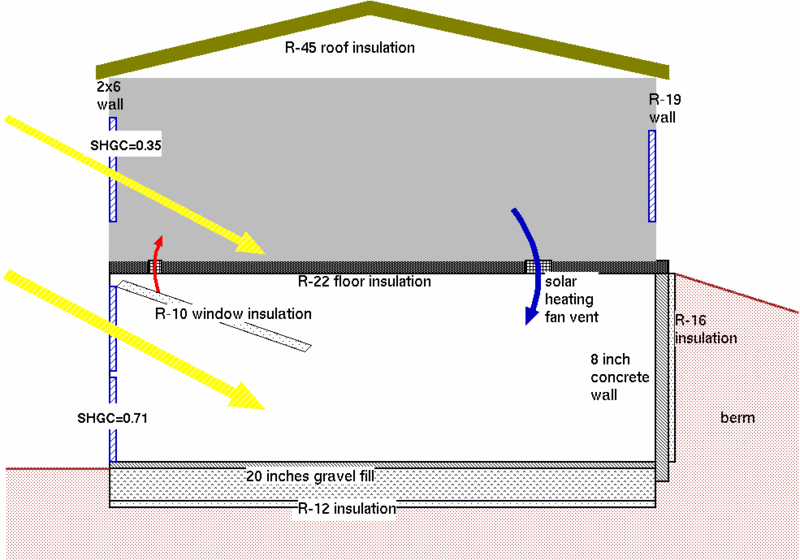
The basement of our house has been designed to serve several functions simultaneously. Like all foundations, it provides support to the house, but it is unusual because it also functions as a solar collector and thermal storage unit. The basement is not used for living space, though it is used for storage. The south wall of the foundation, which is 58 feet long, has a total of 14 46 inch by 76 inch insulated glass panes. We selected AFG industries Comfort E2 coated dual glazed air filled glass panes. There are 12 windows and one 7 foot wide sliding glass door. There are no other windows or doors. The windows are insulated with 1.5 inch thick Thermax (polyisocyanurate) panels during the night. The window insulation is raised and lowered under computer control with a garage door opener. The basement temperature is warmer than usual indoor temperatures, especially in the fall, which means it holds more thermal energy for the same mass compared to a traditional solar house. Separating the solar collector from the house has the additional benefit that the majority of the windows in the house need not face south. Our lot has wonderful views in many directions.
The basement floor is a four inch thick concrete slab, painted black for efficient absorption of sunlight. Most of the thermal mass is below the slab in two feet of gravel fill, which is underlaid by 3 inch thick EPS insulation. The basement north, east, and west walls are 8 inch thick reinforced concrete, insulated on the outside with 4 inches thick EPS. Due to a contractor error, there is a two foot gap with no insulation around the foundation beneath the walls. The north, east and west walls of the basement are bermed, making the house effectively one story on the north side, and apparently two story on the south side. The basement has a framed room with the batteries and inverter for the photovoltaic system and a pressure tank to hold water from the well. Most of the space inside the basement is open, permitting air to circulate freely. Heat from the basement is circulated into the house through a system of vents and a computer-controlled 24VDC fan mounted below the floor of the house. In January 2012 we upgraded to a 12 inch Snap-Fan, which is very efficient and much quieter than the old fan. We are monitoring the performance of the solar basement by measuring temperature at several locations (e.g. house, basement air, basement north wall) and the use of the basement-to-house fan and the backup propane furnace.
In January 2010 we installed solar reflecting panels in front of the basement windows to increase the solar energy entering the basement during the spring when the solar elevation angle is increasing rapidly but the outside temperature is still cold. There are seven panels, each approximately 6 ft by 8 ft in size, that are framed with pressure treated 2x4s and sheathed with steel roofing panels that were covered with ReflecTech, a highly reflecting adhesive film. In March 2016 we resurfaced the reflecting panels because the ReflecTech film had badly delaminated in many places due to incorrect installation. We attached PreMirror 11 Optima aluminum sheets from Lorin Industries to the steel roofing panels. The PreMirror 11 aluminum sheets are beautiful and highly effective at reflecting sunlight into the basement. The angle of the solar reflectors is adjustable in discrete increments from about 0o (used from Fall through January) to 28o (used in May). In 2021 we installed a horizontal bar near the top of the windows so that the reflectors could be tilted to near vertical to block most of the sun from the basement in summer. This is useful for preventing the house from overheating in September as the climate warms.